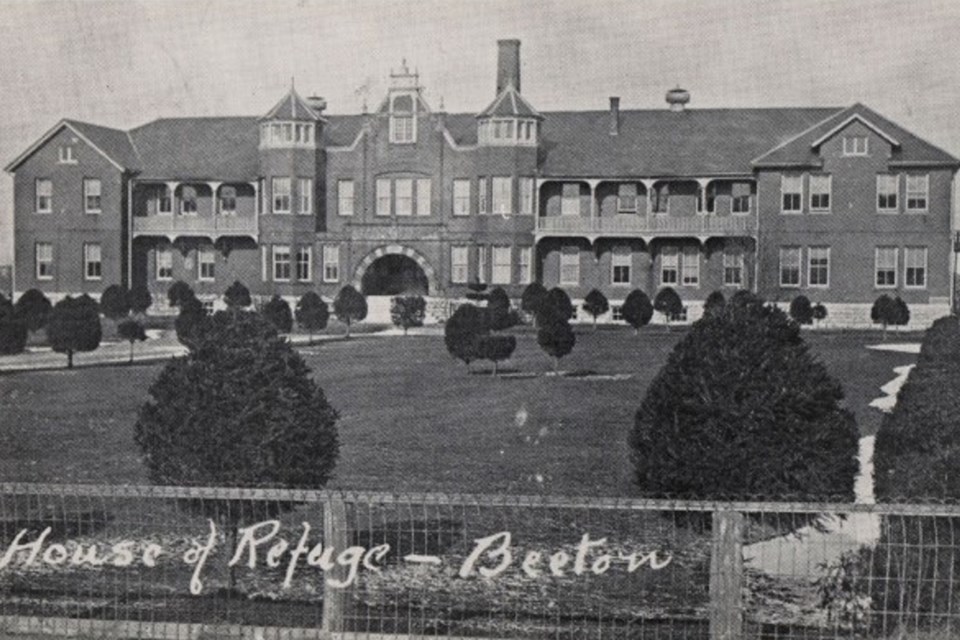Editor's note: To read Part 1, click here.
When Martin Moore, longtime tradesman and well-respected Barrie businessman, reached his later years, some form of dementia began to take hold of him. This cruel fate was made worse by the options of the day – jail, asylum or house of refuge.
In 1901, a 78-year-old Moore was a resident of the recently opened County House of Refuge in Beeton. For a widowed man of advanced years, this institution appeared to be the most suitable for his particular condition.
The facility in Beeton was a shelter for the aged and the poverty-stricken and it had deliberately set itself apart from prisons and asylums. Once admitted, inmates could come and go as they pleased, which was a problem if they were prone to wandering, as Martin Moore was.
By the summer of 1903, the elderly gentleman had walked away from the House of Refuge countless times and had experienced several close calls. The Northern Advance reported on one of Moore’s near-misses in its June 25 edition:
“An inmate, recently committed, Martin Moore, with a greater love evidently for Barrie than the House left in the forepart of last week for the County town. He returned early last Saturday morning, and after a short stay, started on the tramp. He got as far as the 12th line and then lay down on the roadside to rest. A passerby on Sunday noticed the unfortunate man but were not suspicious of anything being wrong. Mr. Neil O’Connor, who had noticed him lying on the roadside the evening before, went over on Sunday morning and found him still lying in the same spot as before.”
On that occasion, Moore was brought to O’Connor’s house where he was given food and drinks. The next day, he was brought to Barrie to be examined and was pronounced insane by two doctors.
Despite being declared unsound of mind, Dr. Wells, the House of Refuge physician, re-admitted Martin Moore. It was apparent to all that this was a bad idea and the local newspapers reported their displeasure. There was an ominous footnote to a Northern Advance editorial on the subject published on Aug. 13, 1903.
“Just as we go to press, we learn that Mr. George Smart found the unfortunate man in the fence corner of one of his fields in an entirely nude condition. He was brought back to the County House.”
Indeed, the news was not good. The following day, Martin Moore succumbed to the effects of prolonged exposure to the outdoor elements.
Outrage was widespread. Everyone had seen this tragedy unfolding in slow motion but nothing had been done to prevent it.
Charles Plaxton, nephew of the deceased, applied to have a coroner’s jury investigate the circumstances of the death and this was granted.
Dr. Wallwin, coroner for the County of Simcoe, took charge of the inquiry, which was held in Beeton in early September 1903.
The jury declared that Martin Moore had died as a result of “old age and imbecility superinduced by exposure caused by his wandering away from the institution.”
The jury exonerated the governor of the institution as houses of refuge in Ontario had no legal powers to restrain or confine residents, regardless of the condition of their health or their mental status.
However, Dr. Wells was rebuked for re-admitting Moore even as two other doctors had declared him insane and recommended that Moore be kept safe in the Barrie Jail until he could be transported to the asylum.
I would be happy to report that circumstances changed rapidly after this, for those experiencing the symptoms of dementia, but that was not the case. Not yet.
It would be a further three years before German psychiatrist and pathologist Alois Alzheimer identified the signs of the form of dementia that would come to bear his name.
Progress in the field remained slow and it was not uncommon for dementia patients, particularly those with hard to manage symptoms, to be housed in mental institutions well into the 20th century.
Each week, the Barrie Historical Archive provides BarrieToday readers with a glimpse of the city’s past. This unique column features photos and stories from years gone by and is sure to appeal to the historian in each of us.

